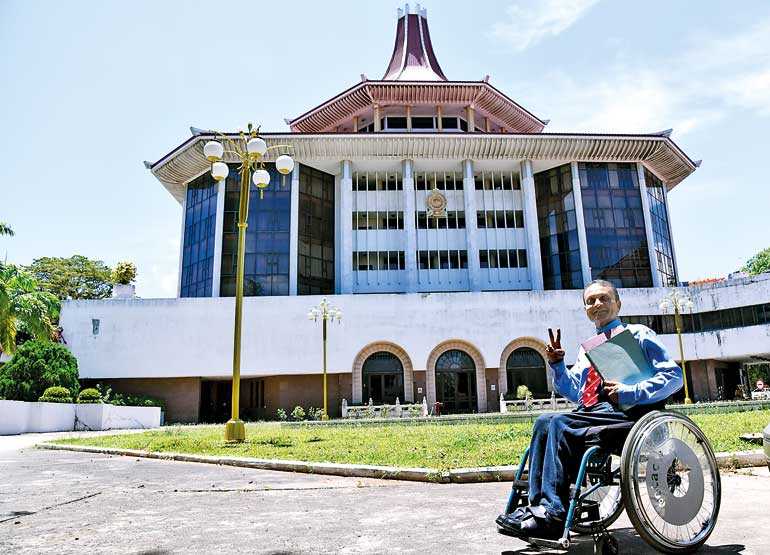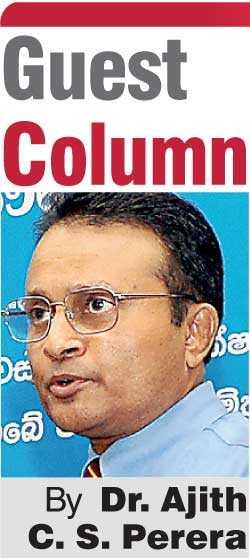Tuesday Mar 04, 2025
Tuesday Mar 04, 2025
Wednesday, 26 June 2019 00:56 - - {{hitsCtrl.values.hits}}

The Supreme Court on 18 April has ordered six Ministries, their Secretaries and three Government authorities to take immediate several effective measures to be enforced in the design and construction of all parts of new buildings and services the public needs to use – as defined in the Gazetted Accessibility Regulations No: 1 of 2006 – and thereby be made easy and safe to access and use, especially by persons with restricted mobility.
SC has further declared that compliance is mandatory, as it’s a high priority must to arrest continual violations of the Fundamental Rights of Sri Lanka’s largest minority and the betray of the ratification of the UN CRPD, only to cause unwanted grave social and economic problems.
This landmark judgement given under reference SCFR 273/2018 was recognised by the SC as a very significant achievement as this writer/the petitioner – since 2009, appearing at all times in person on a wheelchair – successfully pursued singlehanded such public interest litigation fundamental rights application concerning a national tragedy and of international importance to Sri Lanka.
A national crime!
Accessibility is an inherent right of everyone. It cannot be negotiated or diluted by anyone under any circumstances. It forms the foundation of freedom, justice and dignity.
But still, in a 28-page-long judgement SC clearly states: “Despite the passage of 13 years, there is large-scale and substantial non-compliance of meaningful implementation of these Gazetted accessibility regulations by the heads of state and owners of the private sector institutions.
“These include numerous new buildings people need daily including at several reputed hotels, shopping complexes hospitals – toilets, washrooms, restaurants and counters in particular –  and thereby pose numerous unwanted hardship and safety hazards to most clients/patients.”
and thereby pose numerous unwanted hardship and safety hazards to most clients/patients.”
These safety hazards inhumanely hinder or prevent an estimated three to four million people from taking a full part in social and economic life, thereby forcing them to live on the margins of society.
At this time, over an estimated 20% of Sri Lanka’s population – i.e. four million people – have impediments to their physical mobility, stability, dexterity or eyesight. This means one in every five people of Sri Lanka has to deal with limitations in ability in day-to-day living in an undesirable built social environment explained above.This includes those over 65 years (almost a sixth of our population), people living with numerous debilitating medical conditions, those convalescing, those who use wheelchairs and sticks, and also the pregnant. It may be them today, but, it is more than likely to be us or our loved ones tomorrow. Thus, why should man continue to spend money, effort and time in constructing inhumanely such physical barriers?
You will soon realise that the world around once you knew to be cheerful and kind, is no more so, as you are often marginalised beyond expectations and unwantedly depending on others.
When ability gets restricted, why should simple everyday activities become so very complicated, unsafe and disastrous?
It is the way we design and we build the environments we need to use in daily life that makes us able or at a dis-advantage and thereby live life to its fullest with dignity and with safety.
Tormenting consequences awaiting you
(i). Danger of injury and potential threats to safety to life.
(ii). Waste productive human potential
(iii). Drive towards poverty, and as SC concluded,
(iv). “Denial of opportunity of equality and the protection assured by the provisions of this Act and thereby continual violation of the Fundamental Rights guaranteed by Article 12(1) and Article 14(1)(h) of the Constitution, to the Petitioner Dr. Perera and others similarly circumstanced with restricted mobility”.
(v). The trauma of exclusion by built environments precipitate despair, depression, grief and phobia with the enhanced possibility of psychosomatic illnesses, potentially crippling precious human life – economically, socially and mentally.
(vi). The long term mega-development projects are inextricably entwined with the future of future generations of Sri Lankans. With this on-going adverse trend the next generation of persons suffering from mobility impediments - much larger than at present – will face far worsening consequences.
From darkness to light
To make all parts of buildings and facilities that the public needs to access ‘enabling and safe for all’ is a low-cost feasible indispensable investment as part of good business sense.
For businesses to grow and achieve maximum potential, their customer base also needs to grow.
Today no company can afford to marginalise anybody who wants to do business with them, especially an ever increasing larger pool of potential customers that includes those with restricted mobility.
Not only do they form a significant proportion of the population, but they are also often accompanied by able-bodied friends or family as well
It’s good customer care to get the top management commitment to make your business premises open equally to every potential customer.Environments that are easily accessible to everyone equally will be creating a reputation no more can ever buy them, as a people’s caring organisation.
This is imperative to survive and succeed to today’s highly competitive business environment.
Yet, most businesses, still, fail to recognise opening doors equally to all is untapped lucrative businesses and thereby continue to lose vast amounts of revenue and customers due to disabling environments causing exclusion of this diverse and fast-growing customer base.
The tourism industry here in particular is one example. Unoccupied rooms destroy revenue opportunity and kill big part of in-house income earned through profit centres as restaurants and room services.
Hence, there is an increasingly strong financial incentive to make hotel and other facilities safe and accessible equally to everyone and thereby optimise room occupancy over all 12 months of the year. But its recognition needs the vision and leadership.
This is not another mere SC judgement but concerns a public interest litigation of national importance concerning the continual violation of the Fundamental Rights of the country’s largest minority of people. Hence, it is a national tragedy that this writer/petitioner – a T12 paraplegic with even no regular means for existence – find no mechanism in place in our systems for Government and/or other support, even for the respondents, governors, Parliamentarians and other key decision makers to let know well enough the directions even of our apex court of such national importance.
Popular cost – Myth
Implementation of accessibility measures and SC orders for new buildings are not costly as 85% work is just masonry. It requires no allocation of additional funds.
‘Constructing facilities that are accessible to all is costly and non-essential expense’ is a total misconception.
Accessibility is not an add-on. If the right measures are incorporated rightly at the design stage as an integral part of the development of the construction, the cost incurred will add less than 2% to the total cost of construction.
There are several low cost measures to significantly improve safety and accessibility. The colossal wastes to the country and human life caused by the failures to implement SC Orders is huge compared to the money needed.
However, designing for inclusion requires a wide and thorough practical understanding of the intricacies involved.
There cannot be any margin for error as it is a highly responsible task concerning human life.
Furthermore, every building and site is unique in its access and egress problems and solutions. So each site must be assessed separately. Not to do that is a costly blunder we often see made even by giants in businesses.
As such, it is highly advisable that the key decision makers must seek expert guidance – from the start itself – especially from those with proven competence and wide experience.
Main concerns and serious lapses
To arrest this national tragedy we must minimise the gap between the laws and ground reality. The letter of the law needs to be turned – and turned faster – into reality.
Many organisations, commissions and individuals cry loud once in a blue moon. But the politicians, decision makers and even the UN HRC, still, turn blind eyes and deaf ears and thereby make this largest minority remain the silent sufferers of humanity.
They injuriously FAIL to recognise their abilities within dis-abilities and comply with UN CRPD Article 8.
The SC even states: “The specific provisions of the Disability Rights Protection Act No. 28 of 1996 to punish the violators, although in force for 23 years, have never been used and thereby violators, still, continue to go free.”No wonder the violators take laws to their hand and continue to violate the law and victimised parties – that includes the country – get severely punished incurring very big losers that can never be compensated by money.
This is not another mere SC judgement but concerns a public interest litigation of national importance concerning the continual violation of the Fundamental Rights of the country’s largest minority of people.
Hence, it is a national tragedy that this writer/petitioner – a T12 paraplegic with even no regular means for existence – find no mechanism in place in our systems for Government and/or other support, even for the respondents, governors, Parliamentarians and other key decision makers to let know well enough the directions even of our apex court of such national importance.
Attorney General – the 9th Respondent – is the principal legal officer of this country and also the protector of the public rights of the public.
Hence, we the largest minority of people of this country, appeal to him to take the long-awaited speedy initiatives here for effective awareness and implementation of the SC directions of 2011, 2013 and 2019 and set an excellent example to all others.
[The writer ([email protected]) – a paraplegic since 1992 – is a professional and a former senior
manager in industry. Personal adversity has turned him the
pioneer voluntary accessibility rights activist and an
internationally-recognised and a competent advisor on accessibility – trained even in England – with over 21 years of widest practical experience. See: goo.gl/tZZsmz]
Discover Kapruka, the leading online shopping platform in Sri Lanka, where you can conveniently send Gifts and Flowers to your loved ones for any event including Valentine ’s Day. Explore a wide range of popular Shopping Categories on Kapruka, including Toys, Groceries, Electronics, Birthday Cakes, Fruits, Chocolates, Flower Bouquets, Clothing, Watches, Lingerie, Gift Sets and Jewellery. Also if you’re interested in selling with Kapruka, Partner Central by Kapruka is the best solution to start with. Moreover, through Kapruka Global Shop, you can also enjoy the convenience of purchasing products from renowned platforms like Amazon and eBay and have them delivered to Sri Lanka.
Discover Kapruka, the leading online shopping platform in Sri Lanka, where you can conveniently send Gifts and Flowers to your loved ones for any event including Valentine ’s Day. Explore a wide range of popular Shopping Categories on Kapruka, including Toys, Groceries, Electronics, Birthday Cakes, Fruits, Chocolates, Flower Bouquets, Clothing, Watches, Lingerie, Gift Sets and Jewellery. Also if you’re interested in selling with Kapruka, Partner Central by Kapruka is the best solution to start with. Moreover, through Kapruka Global Shop, you can also enjoy the convenience of purchasing products from renowned platforms like Amazon and eBay and have them delivered to Sri Lanka.